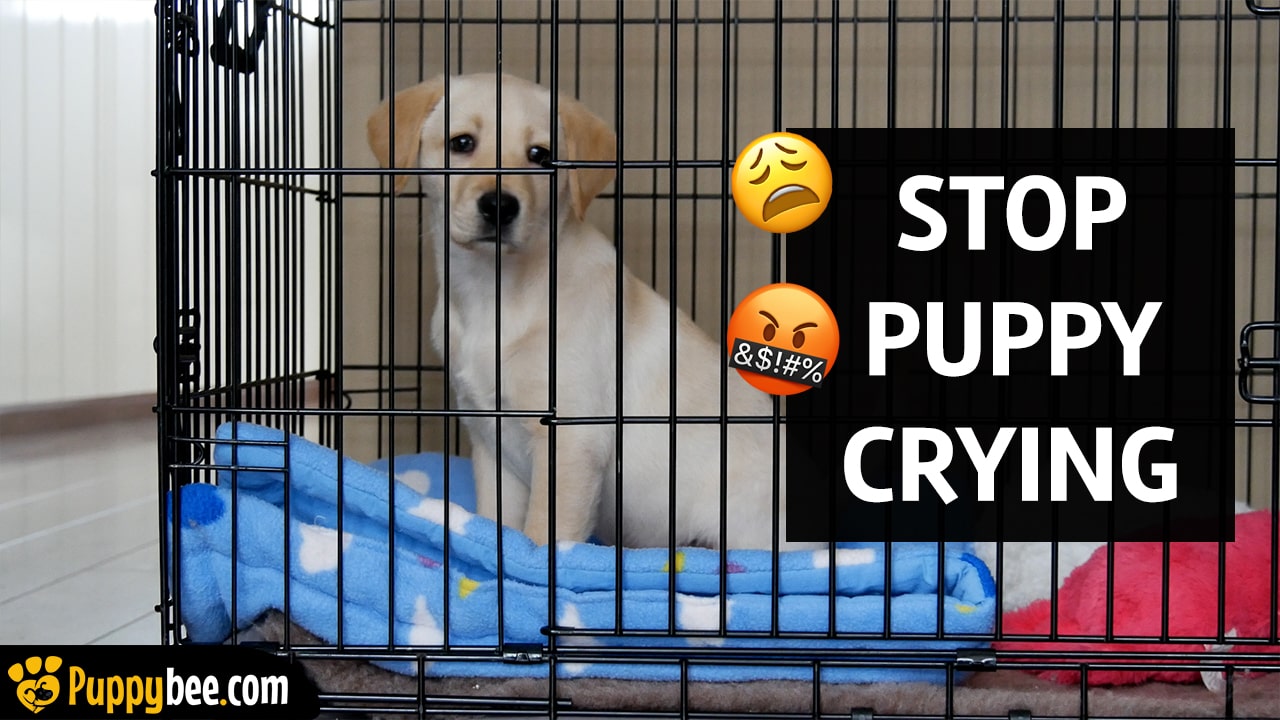To calm a crying puppy during crate training, try gradually introducing them to the crate and providing reassuring comforts like familiar scents and calming music. Introducing crate training to a puppy can be a challenging process.
The crying and whining can be distressing for both the pup and the owner. However, it is important to address this behavior promptly and effectively to avoid creating a negative association with the crate. This article will provide you with practical tips on how to soothe a crying puppy during crate training.
By implementing these strategies, you can help your furry friend feel secure and comfortable in their crate, making the training process smoother for both of you.

Credit: m.youtube.com
Understanding Crate Training
Understanding Crate Training:
Crate training is an effective way to train a puppy and provide them with a secure space of their own. By understanding the benefits of crate training, you can ensure a positive experience for both you and your furry friend.
Benefits of Crate Training:
- Security and Comfort: A crate acts as a den for a puppy, providing them with a safe and cozy environment.
- Potty Training Aid: Dogs naturally avoid soiling their sleeping area, making crate training an excellent tool for potty training.
- Prevention of Destructive Behavior: When properly introduced, a crate can prevent puppies from chewing on furniture or engaging in other destructive behaviors.
- Traveling Convenience: Crates are useful for car journeys, helping to reduce anxiety and providing a familiar space for your puppy.
Importance of Positive Associations:
It’s crucial to create a positive association with the crate to avoid crying during crate training. Introduce the crate gradually, using treats, praise, and favorite toys to make it an inviting space. Make sure to never use the crate as a punishment or force your puppy into it. By associating the crate with positive experiences, you can help your puppy feel comfortable and secure, leading to successful crate training.
Common Reasons For Puppy Crying
Separation Anxiety: When a puppy is crying during crate training, it could be due to separation anxiety. Puppies often feel anxious and distressed when they are separated from their owners.
Need for Bathroom Break: Another common reason for puppy crying is the need to go to the bathroom. Puppies have small bladders and may need to relieve themselves frequently, especially during crate training.
Establishing A Routine
When crate training a puppy, it’s important to establish a routine. Make sure to maintain a consistent feeding schedule and provide regular potty breaks. This will help your puppy to feel more secure and comfortable in their crate. Consistency is key in crate training, so try to stick to the same routine every day. By doing so, your puppy will learn to associate the crate with positive experiences and feel less anxious when left alone. Additionally, creating a predictable routine can help reduce crying and whining during crate training sessions.

Credit: m.youtube.com
Creating A Comfortable Environment
When crate training a puppy and they start crying, it’s important to create a comfortable environment for them. One of the key factors is choosing the right crate size. Make sure the crate is not too big or too small, as this can cause anxiety and discomfort. The crate should be just big enough for the puppy to stand up, turn around, and lie down comfortably. Adding familiar items to the crate can help provide a sense of security and make the space more inviting. You can place a small blanket or a familiar toy inside the crate to make it feel like a safe and cozy den. Remember, the goal is to create a space that feels secure and comfortable for your puppy, so they can gradually become more relaxed and content during crate training.
Implementing Calming Techniques
Implementing Calming Techniques:
Choose a quiet environment for crate training to reduce distractions. A white noise machine can help drown out external sounds and soothe the puppy. Calming pheromones, such as Adaptil, can create a sense of security in the crate.

Credit: www.puppybee.com
Positive Reinforcement
When a puppy cries during crate training, use positive reinforcement by rewarding quiet behavior with treats or praise. Show patience and avoid reacting to the crying to prevent reinforcing it. Gradually increase crate time and make it a positive experience for the puppy.
| Rewarding Quiet Behavior |
| Avoiding Reactivity |
Crate training a puppy can be challenging but using positive reinforcement techniques can help. When your puppy is crying, try rewarding quiet behavior with treats or praise. Avoid reacting to their cries to prevent reinforcing the behavior. Remain calm and patient during the process to prevent any reactivity from the puppy. Consistency is key when it comes to crate training, so ensure you stick to the training routine. Remember, puppies need time to adjust, so be patient and persistent in your efforts.
Seeking Professional Help
Consulting a Trainer: If you’re struggling with crate training and your puppy is crying excessively, it may be beneficial to seek the guidance of a professional dog trainer. They can assess the situation and provide you with effective techniques to help your puppy adjust to being in the crate. Look for a trainer who specializes in positive reinforcement methods, as these techniques promote a healthy and happy training experience for your furry friend.
Veterinary Examination: If your puppy’s crying persists despite your best efforts, it’s crucial to rule out any underlying medical conditions. Schedule a visit with your veterinarian to ensure no health issues are causing the distress. They will be able to conduct a thorough examination and provide appropriate treatment if necessary. Your vet can also offer specific advice based on your puppy’s individual needs.
Ensuring Patience And Consistency
When crate training a puppy, it’s essential to understand that the process takes time. Puppies may cry initially as they get used to the crate, so patience is crucial. Consistency in the training approach is key to the best results. Ensure that the puppy has familiar items in the crate, such as toys and a blanket to provide comfort. Gradually increase the amount of time the puppy spends in the crate, starting with short intervals and gradually extending them. Ignore the crying if the puppy is in a safe and secure environment. Regularly praise and reward the puppy for calm behavior while in the crate to reinforce positive associations. Remember, crate training requires understanding, patience, and a consistent, positive approach, which will help the puppy adjust and feel secure in their crate.
Frequently Asked Questions
How Do I Get My Puppy To Stop Crying In The Crate?
To stop your puppy from crying in the crate, gradually increase crate time, use a cozy blanket, offer treats, and practice positive reinforcement when they are calm.
Should I Let A Puppy Cry It Out?
Yes, you can let a puppy cry it out, but it’s important to consider their needs. Leaving a puppy alone for long periods can be distressing. Gradually increase their alone time and offer comfort to help them feel secure. Consult a professional trainer for guidance.
How Do I Calm My Puppy In His Crate At Night?
To calm your puppy in his crate at night, create a comfortable environment with a cozy bed and familiar toys. Establish a bedtime routine, provide a soothing background noise, and give him a treat before bedtime. Consistency and patience are key to helping your puppy feel secure and relaxed.
Does Putting A Blanket Over A Dog Crate Help?
Yes, putting a blanket over a dog crate can help create a cozy and secure environment for your dog. It can help reduce anxiety and provide a sense of privacy for your pet. However, it’s important to ensure proper ventilation and monitor your dog’s comfort.
Conclusion
Overall, crate training can be a challenging process, especially when it comes to dealing with a crying puppy. However, by understanding the reasons behind their distress and implementing some effective strategies, you can help your furry friend adjust to their crate in a positive way.
Remember to be patient, and consistent, and offer reassurance to your puppy as they learn to feel safe and secure in their new space. By following these tips, you can pave the way for a harmonious relationship between you and your crate-trained puppy.

Hello, I’m Ethan Mitchell. My passion is dog training and behavior enthusiasts. With years of experience working with various breeds, my goal at Dog Advisor Pro is to help dog owners build strong, loving relationships with their furry friends through effective training techniques. Understanding a dog’s behavior is the key to harmonious companionship. I am dedicated to sharing practical training tips that improve the lives of dogs and their owners.


